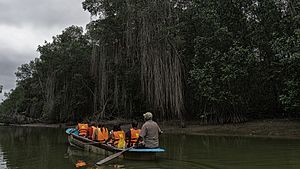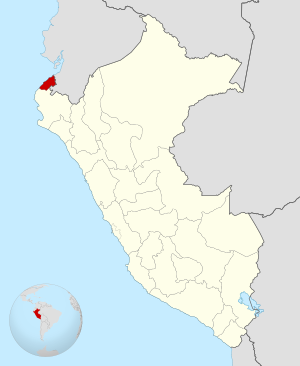Department of Tumbes facts for kids
Quick facts for kids
Department of Tumbes
|
|||
|---|---|---|---|

Manglares de Tumbes National Sanctuary
|
|||
|
|||

Location of the Tumbes Region in Peru
|
|||
| Country | Peru | ||
| Subdivisions | 3 provinces and 12 districts | ||
| Capital | Tumbes | ||
| Area | |||
| • Total | 4,045.86 km2 (1,562.12 sq mi) | ||
| Elevation
(Capital)
|
7 m (23 ft) | ||
| Highest elevation | 134 m (440 ft) | ||
| Lowest elevation | 0 m (0 ft) | ||
| Population
(2017)
|
|||
| • Total | 224,863 | ||
| • Density | 55.57854/km2 (143.9478/sq mi) | ||
| UBIGEO |
24
|
||
| Dialing code | 072 | ||
| ISO 3166 code | PE-TUM | ||
| Principal resources | Petroleum, tobacco, bananas and fishing. | ||
| Poverty rate | 46.8% | ||
| Percentage of Peru's GDP | 0.49% | ||
| Website | www.regiontumbes.gob.pe | ||
Tumbes (Spanish pronunciation: [ˈtumbes]) is a coastal area and a special region in northwestern Peru. It shares a border with Ecuador. Because Tumbes is close to the Equator, it has a warm climate. Its beaches are known as some of the best in Peru. Even though it's a small area, Tumbes has many different types of ecosystems. It is the smallest region in Peru. It also has one of the lowest populations, but it is quite densely populated.
The name "Tumbes" might come from a few places. It could be from Tumpis, who were native people living there. Another idea is the word tumbos, which is a type of fruit plant that grew a lot in the area. It might also be named after a leader called Tumba, whose son helped start the area.
Contents
Geography of Tumbes
The Tumbes Region is located in a special spot. To the east, it borders two provinces of Ecuador: El Oro and Loja. To the south, it borders Peru's Piura Region. The Pacific Ocean is to its north and west.
Tumbes has different types of land. There's a river delta where the Tumbes and Zarumilla rivers meet the sea. There's also a flat area north of the Tumbes River with dry, shallow valleys. You can find old, worn-down hills in the Máncora area. In the east and south, there are the Amotape mountains. The Tumbes river delta is shallow. When the water is low, small sandy islands appear. These islands are covered with mangrove plants.
Even though Tumbes is one of Peru's smallest regions, it has many different environments. These include mangroves, dry forests, and Peru's only coastal tropical forests. It also has a rich and warm sea. About half of Tumbes is covered by three protected natural areas. These are the Manglares de Tumbes National Sanctuary, the Cerros de Amotape National Park, and the Tumbes Reserved Zone. These places help protect the unique plants and animals of the region.
People of Tumbes
The people of Tumbes are mostly a mix of cultures. They come from the ancient Tumpis and Tallanes tribes, Spanish settlers, and African people. There is also a small Chinese community.
How Many People Live Here?
In 2005, it was estimated that about 215,634 people lived in the Tumbes region.
Languages Spoken
Most people in Tumbes (about 98.3%) speak Spanish as their first language. A small number of people also speak Quechua or other native languages.
People Moving In
About 29.4% of the people in Tumbes have moved there from other regions of Peru. A very small number (0.2%) were born in other countries. Many people move from the Piura and Lambayeque areas.
Age Groups
The population in Tumbes is quite young. About 49.4% of the people are under 20 years old. About 3.5% are 65 years old or older.
Education in Tumbes
Most people in Tumbes can read and write, with a literacy rate of 90.4%. Many people have finished high school. Some have also gone on to higher education at colleges or universities.
How Tumbes is Governed
The Tumbes region is divided into three main areas called provinces. These provinces are then split into smaller areas called districts. There are twelve districts in total.
The three provinces and their main towns are:
- Contralmirante Villar (main town: Zorritos)
- Tumbes (main town: Tumbes)
- Zarumilla (main town: Zarumilla)
History of Tumbes
Tumbes was a busy place long before the Inca Empire existed. The first people who lived here were fishermen and hunters. Later cultures that lived in Tumbes were very skilled. They made beautiful pottery and built impressive ruins, some of which you can still see today.
Tumbes became part of the Inca Empire when the Inca leader Pachacuti was in charge. Later Inca rulers, like Tupac Inca Yupanqui and Huayna Capac, continued to make Tumbes an important part of the empire. It was a key starting point for their military trips.
The journey of the Spanish explorers, called Conquistadores, began in Tumbes. Francisco Pizarro and his men landed at Puerto Pizarro looking for gold. From Tumbes, the explorers traveled to other parts of the Inca Empire, setting up new cities and taking control.
During the time when Peru was a Spanish colony, Tumbes was mostly a place where soldiers and adventurers would stop to rest. After Peru became independent, Tumbes became more important. Because it was so close to the border with Ecuador, it became a key spot during conflicts like the Ecuadorian–Peruvian War.
In 2005, people in Tumbes voted on whether their region should join with the regions of Piura and Lambayeque to form a new "Northern Region." However, the people of Tumbes voted against this idea.
Fun Things to See and Do
Places to Visit
Tumbes is very close to the Equator, which means it has lots of plants and a special landscape. The beaches in Tumbes and its warm sea are perfect for surfing and scuba diving. Punta Sal beach is one of the best on the Peruvian coast. It has white sand, sun, and warm weather all year. The sea is great for water sports.
North of Tumbes city is Puerto Pizarro. This is the entrance to the National Mangroves Sanctuary. The mangroves are like forests that grow in saltwater. They create a unique environment where the river meets the sea. These mangroves are where black scallops grow. Black scallops are used in Tumbes' most famous dish, the black scallop ceviche.
South of Tumbes is Zorritos. This town got its name from workers who drilled the first oil well there in 1863. Not far from Zorritos is Bocapán beach. Here, visitors can swim in Hervideros, which are natural hot springs with warm, salty water.
Yummy Food and Drinks
The traditional foods of Tumbes are often made with seafood. You can try ceviche made with black scallops, crab, or shrimp. There's also cebiche mixto, which has a mix of seafood. Another special dish is Tumbiresas. This dish has yucca and banana balls in a broth with meat, red peppers, eggs, olives, raisins, and herbs.
Other tasty dishes include shrimp omelets and crabmeat omelets.
A popular drink in Tumbes is chinguirito. This drink is made by mixing pipa (which is the milk from a young coconut) with a famous grape drink called pisco.
See also
 In Spanish: Departamento de Tumbes para niños
In Spanish: Departamento de Tumbes para niños






